STEVE SIMONTON, Cimarex Energy Co.; EDWIN FELCZAK and ARIEL TORRE, PathFinder, a Schlumberger company
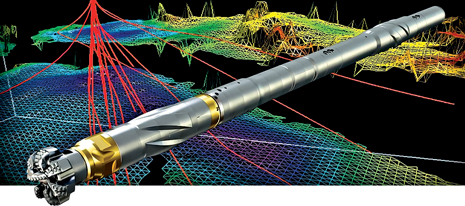 |
| A new high-build-rate RSS provides a deeper kick-off, increased reservoir exposure and faster ROP than positive displacement motors or conventional RSS systems. |
|
Cimarex Energy Co. has been using positive displacement motors (PDM) to drill the curve sections of its wells in the Cana-Woodford shale plays, which require steep dogleg severity (DLS). To overcome drilling challenges, such as increased risk of equipment sticking in the wellbore, greater torque and drag in long, lateral sections, higher wellbore tortuosity, and low rates of penetration (ROP), the operator decided to test a high-build-rate rotary steerable system (RSS). In a drilling campaign of 17 wells, Cimarex experienced the fastest observed ROP in the lateral section, due to smoother wellbores with less tortuosity, as compared to wells drilled with a PDM. Smoother wellbores have also made it easier to run completions equipment.
CANA-WOODFORD SHALE
Oil and gas production from the Cana-Woodford shale play began in the 1930s from conventional vertical wells. Operators in the area introduced horizontal drilling and multistage fracturing techniques in 2005. Since starting operations in the play in 2007, Cimarex Energy Co. has participated in 330 gross (119 net) wells. The company’s fourth-quarter 2011, net production from Cana-Woodford averaged 157.9 MMcfed, a 59% increase vs. the fourth-quarter 2010 average of 99.5 MMcfed.
DRILL-BIT-DRIVEN GROWTH
Cimarex Energy is a Denver-based, independent oil and gas E&P company with principal operations in the Mid-continent, Permian basin and Gulf Coast areas of the U.S. Its business approach is focused on drill-bit-driven growth in production and reserves. The company’s 2011 year-end proved reserves totaled 2.05 Tcfe. These include 863 Bcfe in the western Oklahoma, Cana-Woodford shale play, comprising 492 Bcfe of proved developed and 371 Bcfe of proved undeveloped reserves.
Cimarex relies on its organization of geoscientists to generate drilling prospects. The company has built decentralized exploration teams, who are experts in their regions. A cornerstone to the company’s approach is detailed evaluation of each drilling decision, based on its risk-adjusted, discounted, cash flow rate of return on investment. The analysis includes estimates and assessments of potential reserve size, geological and mechanical risks, expected costs and future production profiles.
DRILLING CHALLENGES
The planned trajectories of Cimarex wells in the Cana-Woodford shale play typically require a DLS of up to 14°/100 ft in the curve section. Until recently, such extreme DLS levels could only be achieved with a PDM. These steerable drilling systems use a motor with a bend that tilts the bit face and cutting structure from the bottomhole assembly (BHA) axis. The whole assembly rotates when drilling in a straight trajectory. When changing trajectory, drillstring rotation is stopped, and the bit is turned by pumping mud through the motor. When the drillstring is not rotating, there is an increased risk of equipment sticking in the wellbore, leading to stress, equipment fatigue and increased possibility of having to abandon the BHA.
When in rotating mode, the bit rotates off-center from the BHA axis and drills a spiral-shaped borehole. The resulting rough sides of the wellbore can cause problems when running complex completion equipment into the hole, due to increased torque and drag, especially in long lateral sections. A further drawback of PDM systems is that they usually deliver a lower ROP compared to RSS’s, and Cimarex considered that the curve sections of its wells in the Cana-Woodford were taking longer to drill than necessary. The company, therefore, investigated alternatives that could speed up the process and help meet its objective for continuous improvement in ROP. In late 2008, Cimarex started to test the PowerDrive Archer high-build-rate RSS, which at the time was still in a pre-commercialization stage. In addition to improving ROP, another key objective was to use the fully rotating design and ability to drill aggressive curves, without sliding, to reduce wellbore tortuosity experienced in wells drilled previously in the field using PDM assemblies.
HIGH BUILD-RATE RSS
The high-build-rate RSS delivers well profiles previously possible only with motors, yet with the ROP and wellbore quality of a fully rotating RSS. The RSS technology usually delivers higher ROP than steerable motor systems, but until now it has been limited by their dogleg drilling capability. The launch of the new high-build-rate RSS has overcome that hurdle. It has internal pads that push against an articulated sleeve pivoted on a universal joint to point the bit in the desired direction. All external parts on the RSS rotate—a feature that reduces the risk of mechanical or differential sticking and improves wellbore quality for easier well completion. The precision steering that high build-rates require is managed by a control system based on the proven, reliable system used in the PowerDrive X6 RSS, which increases the operating envelope for more challenging drilling environments. The radical design of the control unit allows drilling with higher mud weights and a wider flow range. To achieve optimum results, drill bits used with the PowerDrive Archer service can be tailored for specific downhole conditions to enhance steerability, and deliver improved ROP and durability.
High build-rates allow deep kickoffs to place more of the wellbore in the reservoir, thus maximizing drainage capability. Fast, reliable, directional openhole sidetracks can be completed to reduce time on multilateral wells. The new service can provide extra assurance that well profiles can be drilled as planned. The high-build-rate RSS features a closed loop inclination hold mode that ensures pinpoint accuracy at any drilling speed. It can maintain verticality even in high-dipping formations. In horizontal sections, it can drill through hard, interbedded formations at high angles of incidence. The increased dogleg capability gives control in unconsolidated formations and the ability to punch through hard stringers. Pushing the kickoff deeper allows the drilling engineer to reduce risk and cost by reducing the inclination in unstable formations and reducing footage to the reservoir.
CASE HISTORIES
The high-build-rate RSS system was used successfully to drill several Cimarex wells in the Cana-Woodford region.
Kappus 1-22H well. In 2010, the high-build-rate RSS system drilled the 8¾-in curve section of Cimarex’ Kappus 1-22H well (Fig. 1) with an 8°/100 ft DLS, at an ROP 80% faster than achieved for the previous wells, Fig. 2. Although not as high as DLS drilled with mud motors, this DLS was higher than previously achieved with any other RSS. Wellbore tortuosity was reduced by 20% compared with the curve section of the closest offset well drilled with a motor. The high quality of the curve section enabled drilling, using the PowerDrive X5 RSS, of the subsequent 4,353-ft lateral section to TD in one run. Easier drilling operations in the lateral section, combined with faster ROP in the curve section, saved Cimarex a total of ten days compared to the AFE plan. Based on the success of this and other wells, the use of the high-build-rate RSS continued on selected wells.
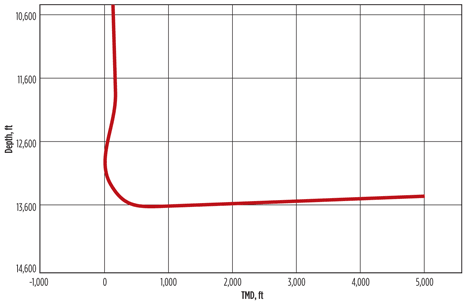 |
| Fig. 1. Profile of Kappus 1-22H well |
|
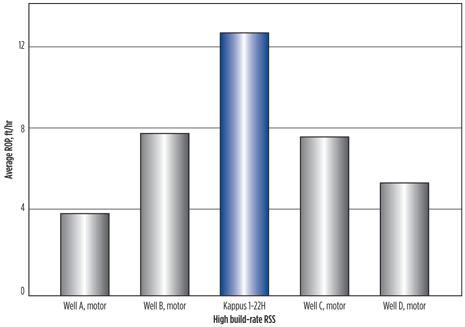 |
| Fig. 2. The average ROP drilling the Kappus 1-22H well was 80% faster than what was achieved in the previous four wells drilled with mud motors. |
|
Clark 1-20H well. As in several other locations around the world, the high build-rate RSS has been achieving ever more demanding DLS in the Woodford Shale. In mid 2011, Cimarex used the system to drill the 8¾-in. curve section of its Clark 1-20H well with a 10°/100-ft DLS. The average ROP of the Clark 1-20H curve section was 15 ft/hr, as compared to an average field ROP of 9.6 ft/hr for curve sections drilled with a PDM assembly, representing an increase of 56%, Fig. 3. The high-build-rate RSS reduced wellbore tortuosity by 16%, compared with the curve section of an offset well drilled with a motor. The high-quality, smooth and consistent wellbore of the curve section subsequently allowed the PowerDrive X6 RSS to drill the 4,763-ft lateral section to TD in one run, with a record average ROP of 120.6 ft/hr. Using RSS to drill both the curve and lateral sections of the well resulted in drilling the lateral section in just 2.18 days, setting a new record in the field, Fig. 4. The total time for drilling the well was significantly less than for other wells in the field, Fig. 5.
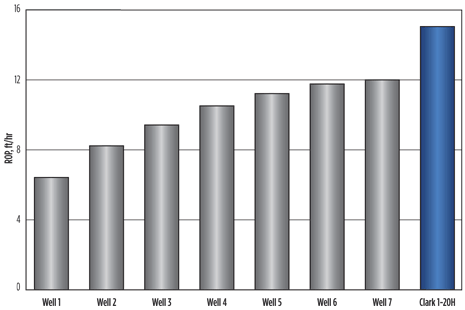 |
| Fig. 3. Average ROP for the Clark 1-20H curve section, drilled with the high-build-rate RSS, was 15 ft/hr compared to a field average of 9.6 ft/hr for curve sections drilled with mud motors; an increase of 56%. |
|
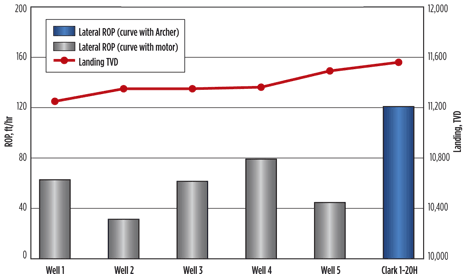 |
| Fig. 4. ROP of Clark 1-20H lateral section compared to ROP of wells within a 2-mi radius, where the curve section was drilled with a mud motor. |
|
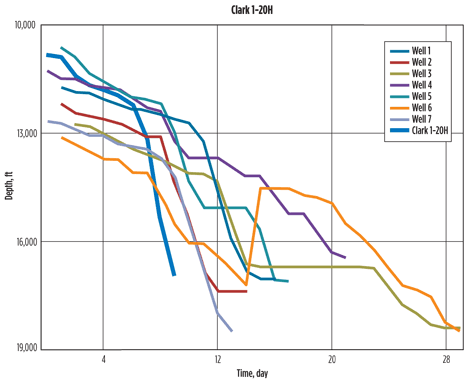 |
| Fig. 5. Total number of days and depth of the Clark 1-20H well drilled, using the high-build-rate RSS compared to wells drilled in the field with a mud motor. |
|
Maib 1-14H well. In the Maib 1-14H well, drilled during late 2011, the high build-rate RSS achieved DLS greater than 10°/100 ft in the curve section. In addition, for the first time, the system was successful in drilling part of the vertical portion prior to buildup (600 ft) and also the initial 800 ft of the lateral run.
SUCCESSFUL SERVICE COMBINATION
To date, 17 wells have been drilled for Cimarex in its Cana-Woodford shale acreage, using the high-build-rate RSS in the curve section. Many of these wells resulted in the lateral sections achieving the fastest observed ROP, due to smoother wellbores with less tortuosity as compared to wells drilled with a PDM. Smoother wellbores have also made it easier to run completions equipment. Cimarex has also used BHA design and drilling services, and high-performance drilling fluids and drill bits from the same oil field service company, to improve drilling efficiency. Related services include an interactive drilling operations center that provides proactive monitoring, expert advice, and guidance while drilling. The drilling team also performed careful analysis of the gamma ray data from offset wells, for the prediction of drop zones for adjusting the steering ratio of the tool to mitigate falling below the plan. The combination of advanced directional drilling technology and expert support has been a key to the success of Cimarex’s field development operations in the Cana-Woodford shale play. 
|
HIGH-BUILD-RATE ROTARY STEERABLE SYSTEM: A NEW TOOL FOR THE DRILLING ENGINEER
The high build rates that the PowerDrive Archer RSS can deliver have found a market in the unconventional resource plays of North America, and its capabilities are gaining the system usage among operators around the world.
High build rates. The RSS system delivers high build rates from any inclination—in field trials, more than 17°/100 ft. All the system parts rotate, which reduces the risk of mechanical or differential sticking and improves borehole quality for easier well completion.
Increased reservoir exposure. The system eliminates flat time because it can kick-off from vertical, drill complete curves and trajectories, drill complex curves and trajectories, drill horizontal sections and perform openhole sidetracks in one run without requiring a trip out of the hole. Higher build-rate capability allows the RSS to kick off deeper and land early in the reservoir.
A new tool for the drilling engineer. The PowerDrive Archer RSS can provide extra assurance that well profiles can be drilled as planned. The increased dogleg available gives control in unconsolidated formations and the ability to punch through hard stringers. This has been used effectively in geosteering applications using the PeriScope bed boundary mapper in West Africa and Asia.
Fast, reliable, directional openhole sidetracks can be completed to reduce time on multilateral wells and allow wells to be placed exactly where required. Pushing the kick off deeper allows the drilling engineer to reduce risk and cost, by reducing the inclination in unstable formations and reducing footage to the reservoir.
Control unit with wider operating envelope. The precision steering of the RSS system is managed by a control system that allows drilling with higher mud weights and a much wider flow range. The system also features a closed loop inclination hold mode than ensures accuracy at any drilling speed.
Fully rotating rotary steerable. All external parts on the RSS system rotate, which improves hole cleaning and reduces the risk of stuck pipe. This rotation also increases ROP by eliminating the sliding intervals and trips required when using a positive displacement motor. Wellbores drilled with the RSS system provide smooth wellbores that reduce torque and drag, allowing good weight transfer to the bit to maximize ROP, and can extend the distance horizontal sections can be drilled.
Smooth boreholes ease completions. The smooth boreholes produced by a fully rotating RSS make it easier to run casing and wireline logs. With reduced friction and tortuosity, it is possible to run intelligent completions with a larger OD, as rugosity is reduced. 
|
|
AUTHORS
|
| SIGVE KROHN NAESHEIM is wells project manager for the Knarr Development with BG Group in Norway. He has more than 30 years of experience, in various positions onshore and offshore, with both drilling contractors and major operators. His experience covers Europe, the U.S., South America, the Middle East and Southeast Asia. He holds an MS degree in petroleum engineering from University of Stavanger. |
|
| FRODE LEFDAL is well engineering manager for BG Group in Norway. He holds an MS degree in petroleum engineering from Norwegian University of Science and Technology. He has 15 years of industry experience with major operators, working in Europe and South America. He is BG’s Subject Matter Expert for managed pressure drilling. |
|
| TOR ØYVIND OFTEDAL is chief well engineering manager for BG. He is a petroleum engineer from Rogaland University and has 32 years of experience with the following companies: Phillips Petroleum, Saga Petroleum, Norsk Hydro, ConocoPhillips and BG. He has held engineering positions in: platform/pipeline inspections, drilling and workovers, well intervention and platform operations in Norway, Denmark and UK. He has been a manager/supervisor since 1986. |
|








